The Pinwheel Galaxy is an intermediate spiral galaxy located 20.9 million light years away in the constellation Ursa Major. With an apparent magnitude of 7.9 and an apparent size of 28.8 by 26.9, it is one of the brightest and largest spiral galaxies in the night sky. It is listed as Messier 101 (M101) in the Messier catalogue and NGC 5457 in the New General Catalogue.
The Pinwheel Galaxy is larger than our own Milky Way galaxy. It stretches 169,300 light-years across and is home to 1 trillion stars. It has an angular size only slightly smaller than that of the full Moon. The galactic disk of M101 has a mass of 100 billion solar masses and its bulge of 3 billion Suns.
Messier 101 is a grand design spiral galaxy. It appears face-on and has prominent and well-defined spiral arms that extend around it. As one of the most prominent galaxies in the northern celestial hemisphere, M101 is a popular target for amateur astronomers and astrophotographers.
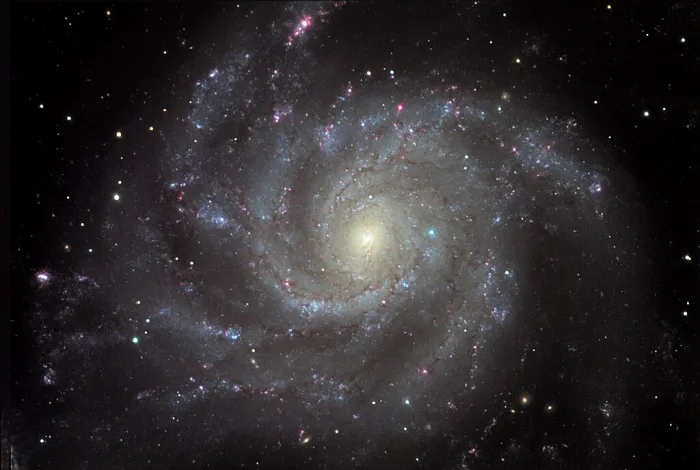
M101 is a large “grand design” spiral galaxy. Even at a distance of 20.9 million light years away, it still sprawls its 170,000 light year diameter across a large patch of the sky. This image only shows the central third of its countenance. Many of the bright star forming regions in the spiral arms have their own NGC designations. Also note the myriad of background galaxies that can be seen in various places through the disk. This image was taken as part of Advanced Observing Program (AOP) program at Kitt Peak Visitor Center during 2014. Credit: KPNO/NOIRLab/NSF/AURA/Adam Block (CC BY 4.0)
The Pinwheel Galaxy appears asymmetrical because it is interacting with several smaller companion galaxies. The tidal interactions have triggered waves of star formation in the spiral arms of M101, observed in the ultraviolet band. The smaller satellite galaxies are members of the M101 Group.
The Pinwheel Galaxy hosts a large number of star forming regions. These HII regions contain many exceptionally hot and luminous young stars that ionize the surrounding gas and dust. As many as 1,264 HII regions were catalogued in M101 in a 1990 study. More recent images have revealed about 3,000 stellar nurseries in the galaxy. The most prominent of these – including NGC 5461, NGC 5462 and NGC 5471 – have their own designations in the New General Catalogue.
Three of these large emission nebulae – NGC 5447 (NGC 5450), NGC 5461 and NGC 5462 – were discovered by the German-born British astronomer Sir William Herschel on April 14, 1789.
Several more star forming regions – including NGC 5449, NGC 5451 and NGC 5453 – were spotted by Irish engineer Bindon Stoney, assistant to William Parsons, 3rd Earl of Rosse, on March 1, 1851. The emission nebula NGC 5471 was discovered by German astronomer Heinrich Louis d’Arrest on August 22, 1863.
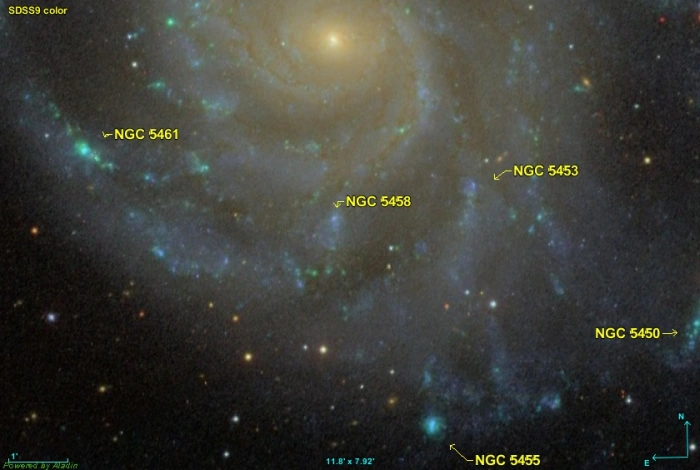
H II regions in the Pinwheel Galaxy (M101), image created using the Aladin Sky Atlas software from the Strasbourg Astronomical Data Center and SDSS (Sloan Digital Sky Survey) public data. Credit: Donald Pelletier (CC BY-SA 4.0)
The Pinwheel Galaxy has around 150 globular clusters, detected by Hubble in the late 1990s and early 2000s. Many of these clusters are faint and very old.
Observations with the Chandra X-ray Observatory in 2001 revealed a prominent X-ray source, P98, in M101. The source was given the designation M101 ULX-1. In 2005, observations with the Hubble Space Telescope and XMM Newton led to the detection of an optical counterpart. Astronomers concluded that the source was likely an X-ray binary system, composed of a main sequence star and a black hole.
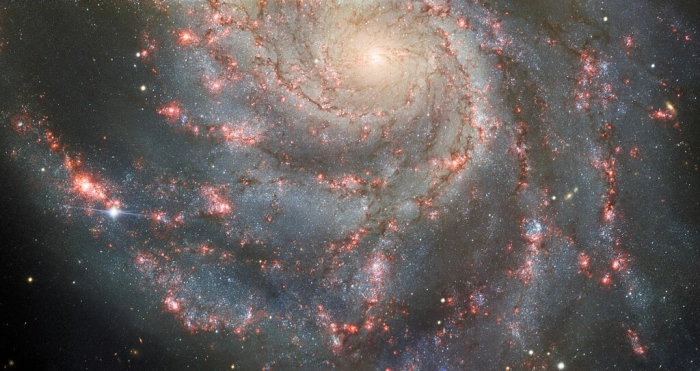
Gemini North, part of the International Gemini Observatory operated by NSF’s NOIRLab, is back observing the night sky following the repair and refurbishment of its primary mirror. The telescope’s debut observation captured the supernova dubbed SN 2023ixf (lower left), which was discovered on 19 May by Japanese astronomer Koichi Itagaki. This dazzling point of light, the closest supernova seen in the past five years, is located along one of the spiral arms of the Pinwheel Galaxy (Messier 101). Credit: International Gemini Observatory/NOIRLab/NSF/AURA Image Processing: J. Miller (Gemini Observatory/NSF’s NOIRLab), M. Rodriguez (Gemini Observatory/NSF’s NOIRLab), M. Zamani (NSF’s NOIRLab), T.A. Rector (University of Alaska Anchorage/NSF’s NOIRLab) & D. de Martin (NSF’s NOIRLab) (CC BY 4.0)
M101 Group
The Pinwheel Galaxy is the most prominent member of the M101 Group, a loose group of galaxies consisting mostly of M101’s companions. The group lies within the Virgo Supercluster (Local Supercluster), which also contains the Virgo Cluster and the Local Group of galaxies. The companions were discovered by William Herschel in 1788 and 1789.
The members of the M101 Group are NGC 5204, NGC 5474, NGC 5477, NGC 5585, UGC 8837, and UGC 9405. The irregular galaxies NGC 5278 and UGC 8508 may also be physically bound to the group. The Pinwheel Galaxy is interacting with most members of the group.
NGC 5204 is a highly irregular Magellanic spiral galaxy located 14 – 14.5 million light-years away. It is 19,000 light-years across. It has an apparent magnitude of 11.73 and an apparent size of 5 by 3 arcseconds. The galaxy was discovered by William Herschel on April 24, 1789.
NGC 5474 is a peculiar dwarf galaxy with an apparent magnitude of 11.3. It lies 21.2 light-years away. It is the nearest companion to the Pinwheel Galaxy and has been heavily distorted by the interaction with its large neighbour. The galaxy was discovered by William Herschel on May 1, 1788.
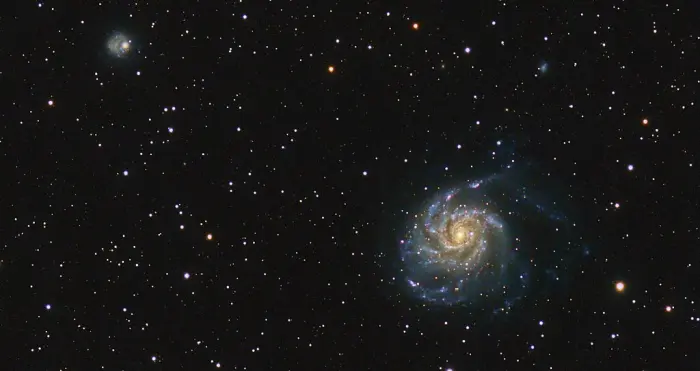
The Pinwheel Galaxy and NGC 5474, image credit: Wikimedia Commons/Keesscherer (CC BY-SA 4.0)
NGC 5477 is a dwarf galaxy located 20 million light years away. It has an apparent magnitude of 14.01. William Herschel discovered it on April 14, 1789.
NGC 5855 is a spiral galaxy with a diameter of 43,000 light-years. It lies about 28 million light years away and has an apparent magnitude of 11.2. It contains 47 known star forming regions and five identified supernova remnants. The galaxy was discovered by William Herschel on April 17, 1789.
UGC 8837 (Holmberg IV) is a dwarf galaxy in the M101 Group. It lies 24 million light years away. It may be one of the galaxies whose interaction with M101 has triggered a burst of star formation in the Pinwheel.
UGC 9405 is a dwarf irregular galaxy 20.5 million light years away. Its membership in the group is uncertain because it lies far from the Pinwheel Galaxy.
The M101 Group lies in the same region of the sky as the M51 Group, centered on the Whirlpool Galaxy (Messier 51) in Canes Venatici, and the NGC 5866 Group, centered on the Spindle Galaxy (Messier 102) in Draco. The M51 Group also includes the bright Sunflower Galaxy (Messier 63).

The Pinwheel Galaxy, image credit: Adam Block/Mount Lemmon SkyCenter/University of Arizona (CC BY-SA 4.0)
Facts
The Pinwheel Galaxy was discovered by the French astronomer Pierre Méchain on March 27, 1781. Méchain notified his friend and colleague Charles Messier of the discovery and Messier added the galaxy to his catalogue as object number 101.
Méchain originally described the galaxy as a “nebula without a star, very obscure and pretty large, 6’ to 7’ in diameter, between the left hand of Böotes and the tail of the Great Bear. It is difficult to distinguish when one lits the [grating] wires.”
Messier 101 was one of the last objects added to the Messier catalogue by Messier himself, along with the galaxy Messier 102 and the open cluster Messier 103. With the deadline for the publication of his catalogue approaching, Messier did not verify Méchain’s observation before including M101 on his list. He observed the galaxy later in 1781, after the final version of his catalogue was published.
Danish astronomer John Louis Emil Dreyer, who compiled the New General Catalogue in 1888, listed M101 as NGC 5457, describing it as “pretty bright, very large, irregularly round, gradually, then very suddenly much brighter middle with bright small nucleus.”
English astronomer Lord Rosse was the first to document the galaxy’s spiral structure in more detail. He observed M101 in his 72-inch Newtonian reflector in the second half of the 19th century and drew three sketches of it. He described it as a “large spiral; faintish; several arms and knots; 14’ across at least.”
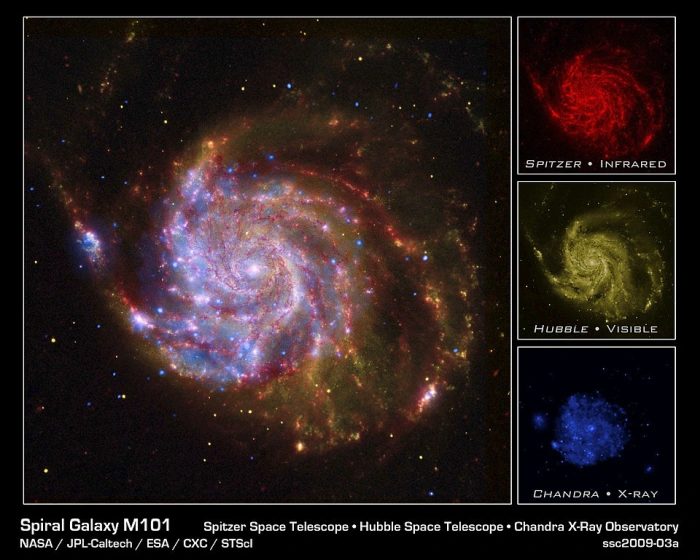
This image of the spiral galaxy Messier 101 is a composite of views from Spitzer, Hubble, and Chandra. The red color shows Spitzer’s view in infrared light. It highlights the heat emitted by dust lanes in the galaxy where stars can form. The yellow color is Hubble’s view in visible light. Most of this light comes from stars, and they trace the same spiral structure as the dust lanes. The blue color shows Chandra’s view in X-ray light. Sources of X-rays include million-degree gas, supernovae, and material colliding around black holes. Such composite images allow astronomers to see how features seen in one wavelength match up with those seen in another wavelength. It’s like seeing with a camera, night vision goggles, and X-ray vision all at once. Credit: NASA, ESA, CXC, JPL, Caltech and STScI (PD)
The Pinwheel Galaxy is listed as Arp 26 in American astronomer Halton Arp’s Atlas of Peculiar Galaxies (1966). Arp included M101 as an example of a spiral galaxy with one heavy arm.
The Pinwheel Galaxy has hosted six observed supernovae in the past century. In January 1909, the German astronomer Max Wolf discovered the supernova SN 1909A, which peaked at magnitude 12.1. In September 1951, the supernova SN 1951H was spotted by the American astronomer Milton Humason. It reached magnitude 17.5.
In 2011, the supernova SN 2011fe shone at magnitude 17.2 at discovery and peaked at magnitude 9.9. It was classified as a type Ia supernova, triggered by an accreting white dwarf.
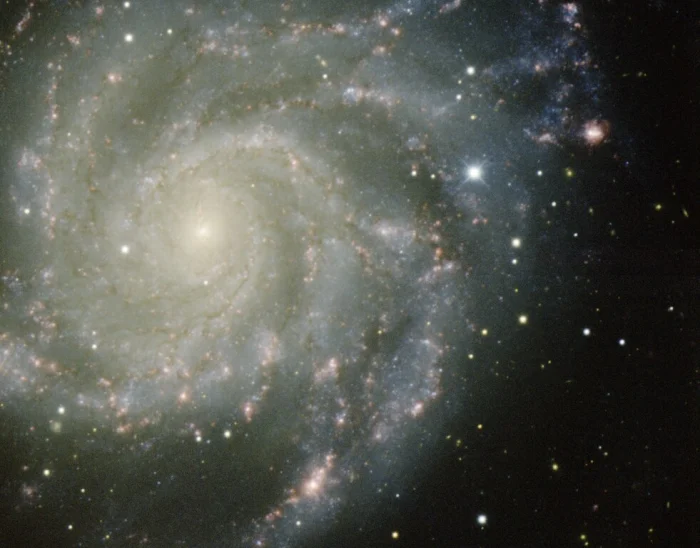
This close-up image of the nearby galaxy M101 was obtained with the Mayall 4-meter telescope at Kitt Peak National Observatory. M101 is a spiral galaxy in the constellation Ursa Major and is quite similar to our own Galaxy. It is about 20 million light years (6.4 Mpc) away. The supernova is clearly visible as the bright, bluish star in the upper, right portion of the image. It is the closest Type 1a supernova to be observed since 1972. This image was obtained on September 18th, 2011, about two weeks after the supernova achieved its peak brightness. This image was created by combining images taken in four filters: B (blue), V (green), I (orange), and Hydrogen-Alpha (red). In the image north is to the left and east is down. Credit: T.A. Rector (University of Alaska Anchorage), H. Schweiker & S. Pakzad NOIRLab/NSF/AURA (CC BY 4.0)
The luminous red nova M101 OT2015-1 was discovered in the Pinwheel Galaxy on February 10, 2015. The nova outburst was caused by the merger of two stars in a contact binary system into a single star. It occurred in the outer portion of M101’s spiral arm.
The most recent supernova, SN 2023ixf, was detected near the star forming region NGC 5461 on May 19, 2023. It was classified as a type II supernova, caused by the rapid core collapse of a massive supergiant star. It had an apparent magnitude of 14.9 at discovery and peaked at magnitude 10.8.

The Fred Lawrence Whipple Observatory’s 48-inch telescope captured this visible-light image of the Pinwheel galaxy (Messier 101) in June 2023. The location of supernova 2023ixf is circled. The observatory, located on Mount Hopkins in Arizona, is operated by the Center for Astrophysics | Harvard & Smithsonian. Hiramatsu et al. 2023/Sebastian Gomez (STScI); NASA’s Scientific Visualization Studio – KBR Wyle Services, LLC/Scott Wiessinger, University of Maryland College Park/Jeanette Kazmierczak (PD)
Messier 101 is the best-known Pinwheel Galaxy in the sky, but it is not the only bright pinwheel-shaped galaxy. Others include the Little Pinwheel Galaxy (NGC 3184) in Ursa Major, the Southern Pinwheel Galaxy (Messier 83, NGC 5236) in Hydra, the Coma Pinwheel Galaxy (Messier 99, NGC 4254) in Coma Berenices, and the Sculptor Pinwheel Galaxy (Caldwell 70, NGC 300) in Sculptor.
The unbarred spiral galaxy NGC 3184 is known as the Little Pinwheel Galaxy. It lies in the region of the Great Bear’s feet, just west of Tania Borealis (Mu Ursae Majoris). Discovered by William Herschel six years after its brighter namesake, the Little Pinwheel has an apparent magnitude of 10.4 and an angular size of 7.4 by 6.9 arcminutes. It is included in the Herschel 400 catalogue of deep sky objects that can be observed in amateur telescopes.
The Southern Pinwheel Galaxy (M83) lies in the constellation Hydra, near the border with Centaurus. The barred spiral galaxy has an apparent visual magnitude of 7.6. Like all Messier objects, it can be spotted in binoculars in good conditions. It is one of the nearest and brightest barred spiral galaxies in the sky.
The Coma Pinwheel Galaxy (M99) lies in the faint constellation Coma Berenices. It is grand design spiral galaxy also known as St. Catharine’s Wheel. With an apparent magnitude of 9.9, it can be observed in small telescopes. The galaxy is a member of the Virgo Cluster. It is sometimes also called the Virgo Cluster Pinwheel.
The Sculptor Pinwheel Galaxy (C70) is one of the nearest galaxies to the Local Group. It looks similar to the Triangulum Galaxy (M33) in the constellation Triangulum. Like its other namesakes, it can be seen in amateur telescopes. It is included in the Caldwell catalogue of objects that can be seen in backyard telescopes. It lies in the constellation Sculptor and has an apparent magnitude of 9.0.
In February 2006, the Pinwheel Galaxy was captured in the largest and most detailed image taken by the Hubble Space Telescope (HST) at the time. The photograph was assembled from multiple images taken by Hubble’s Advanced Camera for Surveys (ACS) and the Wide Field and Planetary Camera 2 (WFPC2) over a period of almost 10 years, as well as from ground-based observations with the Canada-France-Hawaii Telescope and the telescope at the Kitt Peak National Observatory.
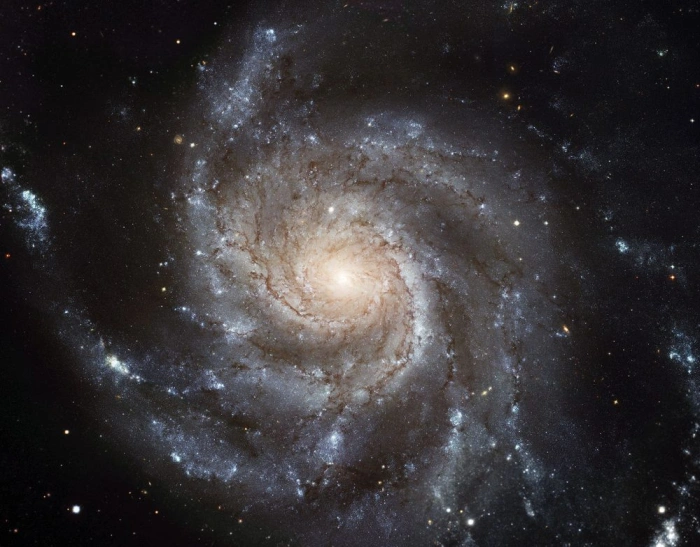
The galaxy Messier 101 (M101, also known as NGC 5457 and also nicknamed the Pinwheel Galaxy) lies in the northern circumpolar constellation, Ursa Major (The Great Bear), at a distance of about 21 million light-years from Earth. This is one of the largest and most detailed photos of a spiral galaxy that have been released from Hubble. The galaxy’s portrait is actually composed of 51 individual Hubble exposures, in addition to elements from images from ground-based photos. Image credit: European Space Agency & NASA; Acknowledgements: K.D. Kuntz (GSFC), F. Bresolin (University of Hawaii), J. Trauger (JPL), J. Mould (NOAO), and Y.-H. Chu (University of Illinois, Urbana); Image processing: Davide De Martin (ESA/Hubble); CFHT image: Canada-France-Hawaii Telescope/J.-C. Cuillandre/Coelum; NOAO image: George Jacoby, Bruce Bohannan, Mark Hanna/NOAO/AURA/NSF (CC BY 4.0)
Location
The Pinwheel Galaxy is very easy to find. It lies in the region of the Big Dipper, one of the brightest and best-known asterisms in the northern sky. The bright galaxy forms an almost equilateral triangle with Alkaid (Eta Ursae Majoris) and Mizar (Zeta Ursae Majoris), the stars at the end of the Great Bear’s tail (or the Big Dipper’s handle).
M101 can be seen in binoculars and small telescopes, but it requires exceptionally good observing conditions. In binoculars, the galaxy looks like a hazy patch. Small telescopes will reveal only the bright central region. In 4-inch and 6-inch telescopes, the galaxy’s spiral arms appear as nebulous patches in very dark skies.
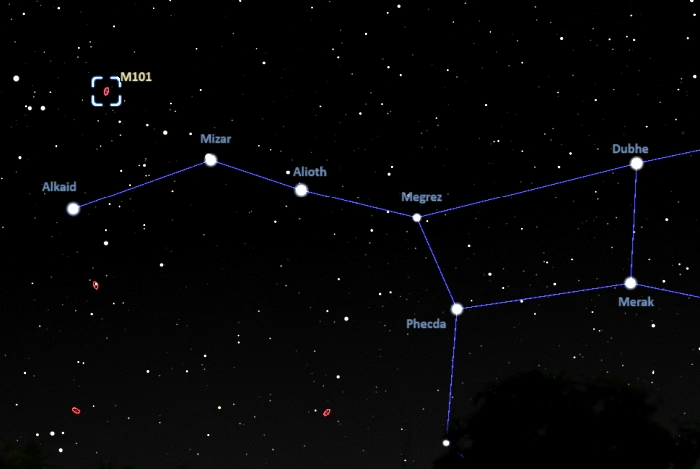
The location of the Pinwheel Galaxy (Messier 101), image: Stellarium
The Pinwheel Galaxy is quite large, but relatively faint, which makes it a challenging target for smaller instruments. It is best seen with a low power eyepiece, without too much magnification, because of its large size. The galaxy’s spiral structure can only be seen in a larger telescope.
Good viewing conditions are essential because the galaxy is too diffuse to be seen from areas with too much light pollution.
At declination +54° 20’, the Pinwheel Galaxy is visible from locations north of the latitude 35° S. It is best seen from the northern hemisphere and never rises very high above the horizon for observers south of the equator.
The best time of the year to observe the Pinwheel Galaxy and other deep sky objects in Ursa Major is during the month of April, when the constellation is high above the horizon around 9 pm.
Pinwheel Galaxy – Messier 101
| Constellation | Ursa Major |
| Object type | Intermediate spiral galaxy |
| Morphological type | SAB(rs)cd |
| Right ascension | 14h 03m 12.583s |
| Declination | +54° 20′ 55.50″ |
| Apparent magnitude | 7.9 |
| Apparent size | 28′.8 × 26′.9 |
| Distance | 20.9 ± 1.8 million light years (6.4 ± 0.5 megaparsecs) |
| Redshift | 0.000804 |
| Heliocentric radial velocity | 241 ± 2 km/s |
| Size | 169,300 light-years (51,910 parsecs) |
| Names and designations | Pinwheel Galaxy, Messier 101, M101, NGC 5457, Arp 26, PGC 55063, LEDA 50063, UGC 8981, MCG+09-23-028, SPB 243, TC 302, K73 610, PSCz Q14013+5435, VV 344, VV 344a, VV 456, UZC J140312.5+542056, Z 272-21, [M98c] 140126.6+543525, [CHM2007] LDC 842 J140312.58+5420555, [CHM2007] HDC 853 J140312.58+5420555, IRAS 14013+5435, IRAS F14012+5434, 2MASX J14031258+5420555, SDSS J140312.52+542056.2 |
Images
Composite
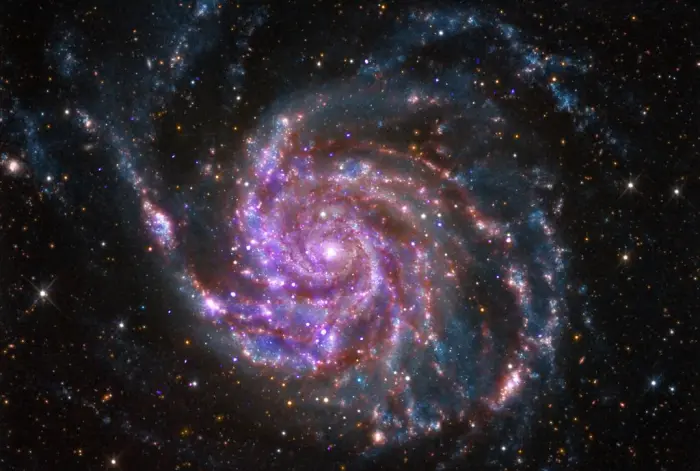
M101 is a spiral galaxy like our Milky Way, but about 70 percent bigger. It is located about 21 million light years from Earth. X-rays from Chandra reveal the hottest and most energetic areas due to supernovae, superheated gas, and material falling toward black holes. Infrared data from Spitzer shows dusty lanes in the galaxy where stars are forming, while optical data traces the light from stars. Credit – X-ray: NASA/CXC/SAO; Optical: Detlef Hartmann; Infrared: NASA/JPL-Caltech (PD)
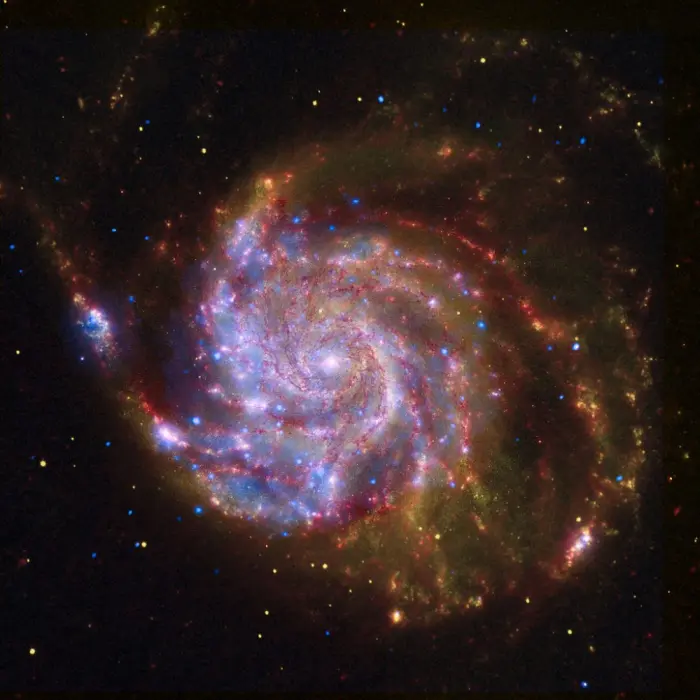
This image of the spiral galaxy Messier 101 is a composite of views from the Spitzer Space Telescope, Hubble Space Telescope, and Chandra X-ray Observatory. Each wavelength region shows different aspects of celestial objects and often reveals new objects that could not otherwise be studied. The red color shows Spitzer’s view in infrared light. It highlights the heat emitted by dust lanes in the galaxy where stars can form. The yellow color is Hubble’s view in visible light. Most of this light comes from stars, and they trace the same spiral structure as the dust lanes. The blue color shows Chandra’s view in X-ray light. Sources of X-rays include million-degree gas, stars that went out as supernovae, and material colliding around black holes. Such composite images allow astronomers to see how features seen in one wavelength match up with those seen in another wavelength. It’s like seeing with a camera, night vision goggles, and X-ray vision all at once. Image: NASA, ESA, CXC, SSC, and STScI (PD)
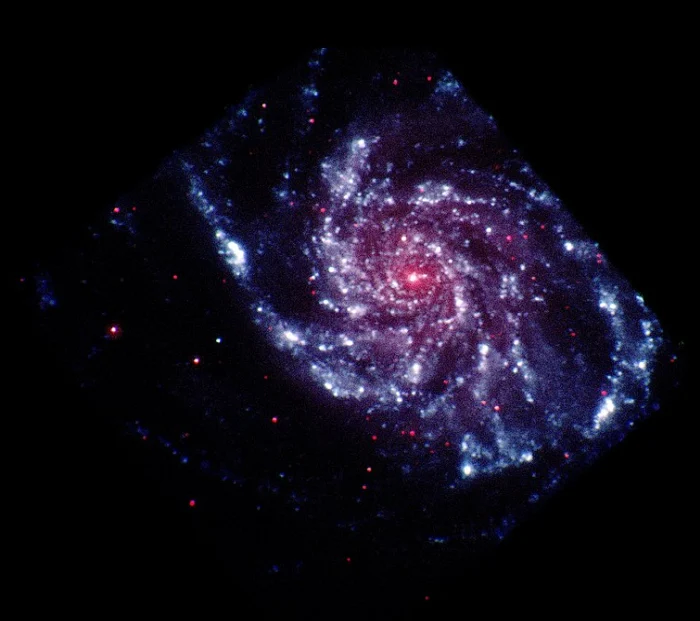
First-light image from the Swift Gamma-Ray Burst Mission’s UVOT instrument, of the M101 “Pinwheel” Galaxy. This UVOT image combines both ultraviolet and visible light from a number of filters. Each filter is sensitive to light of a different color, ranging from ultraviolet light beyond the range of human eyesight through the blue to yellow portion of the visible spectrum. This is a ‘false-color’ image with the shortest wavelength ultraviolet rays being represented as blue, and the longest visible light wavelengths as red. The image shows that hot young stars are being formed in abundance in M101, especially in the spiral arms of the galaxy, where they show up in ultraviolet light. The central regions of the galaxy have more cool, old stars, which appear ‘red’ in the picture. A number of foreground stars, located in our own Galaxy, also reveal themselves by their red color. Image credit: NASA/GSFC (PD)
Visible
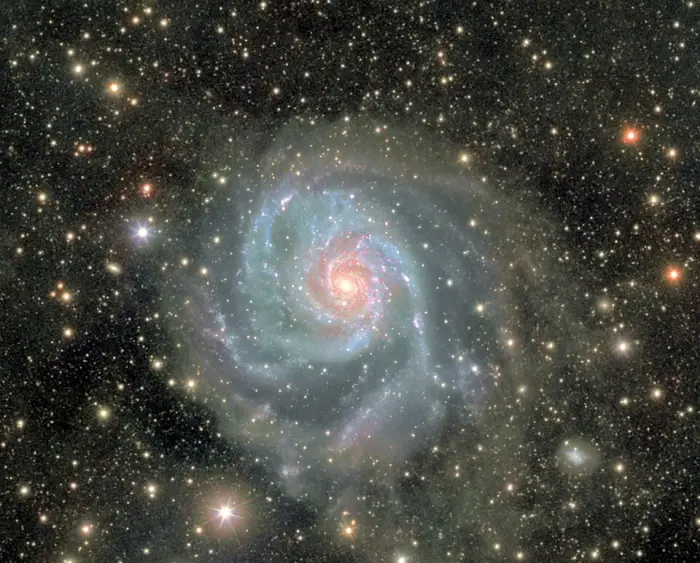
Pinwheel Galaxy (Messier 101), image credit: Paolo Demaria, Giuseppe Donatiello, Mark Elvov, Andrew Genualdi, Zlatko Orbanic, Rolando Ligustri, Andrea Pistocchini, Tim Stone (CC0 1.0)
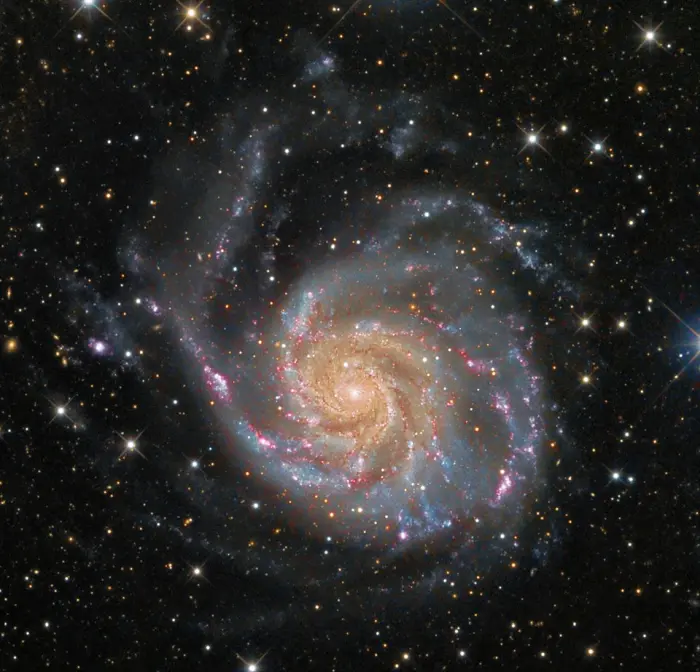
Messier 101, image credit: Paolo Demaria, Giuseppe Donatiello, Mark Elvov, Andrew Genualdi, Zlatko Orbanic, Rolando Ligustri, Andrea Pistocchini, Tim Stone (CC0 1.0)
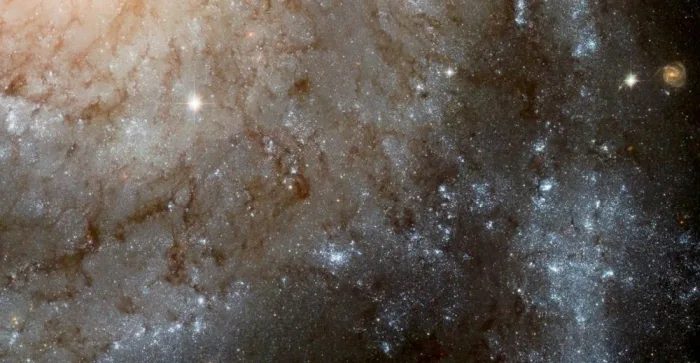
Pinwheel Galaxy detail, credit: NASA and ESA (PD)
Ultraviolet

This ultraviolet image of the giant spiral galaxy Messier 101 (M101) was obtained by the Ultraviolet Imaging Telescope during the Astro-2 mission of the Space Shuttle Endeavour. Image credit: NASA (PD)
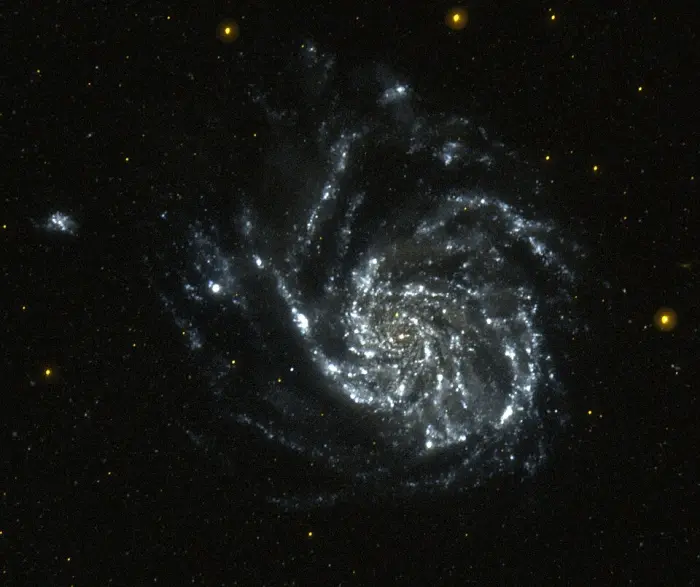
The structural integrity of M101, or the Pinwheel Galaxy, is revealed in this classic image from GALEX.
Unlike our closest large galactic neighbor, the Andromeda galaxy, both young and old stars are evenly distributed along M101’s tightly wound spiral arms. Blue shows the presence of hot, young stars that formed about 10 million years ago, and regions that glow yellow harbor older, cooler stars that are over 100-million years old. This image of the Pinwheel Galaxy is a two-color composite, where far-ultraviolet light is blue, and near-ultraviolet light is red. Credit: NASA/JPL-Caltech (PD)
Infrared
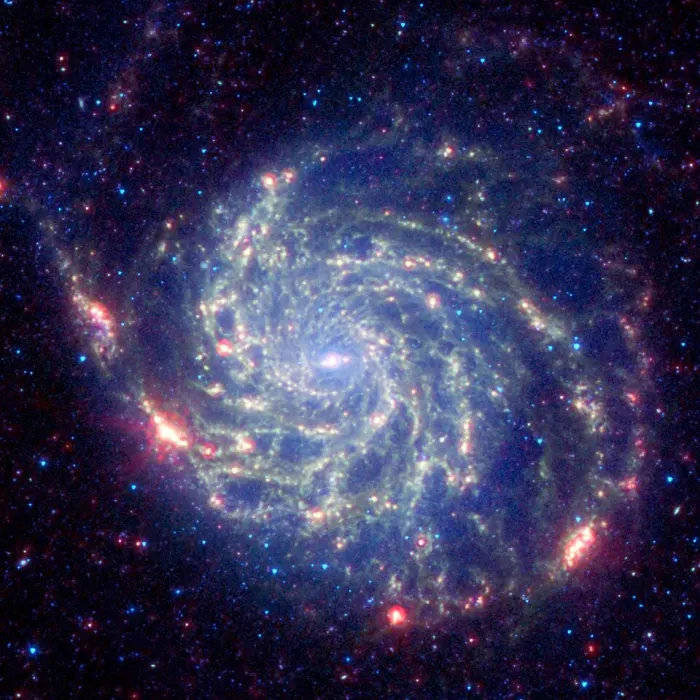
The galaxy Messier 101 is a swirling spiral of stars, gas, and dust. Messier 101 is nearly twice as wide as our Milky Way galaxy. Spitzer’s view, taken in infrared light, reveals the galaxy’s delicate dust lanes as yellow-green filaments. Such dense dust clouds are where new stars can form. In this image, dust warmed by the light of hot, young stars glows red. The rest of the galaxy’s hundreds of billions of stars are less prominent and form a blue haze. Astronomers can use infrared light to examine the dust clouds where stars are born. Credit: NASA, Jet Propulsion Laboratory/Caltech, and K. Gordon (STScI) (PD)
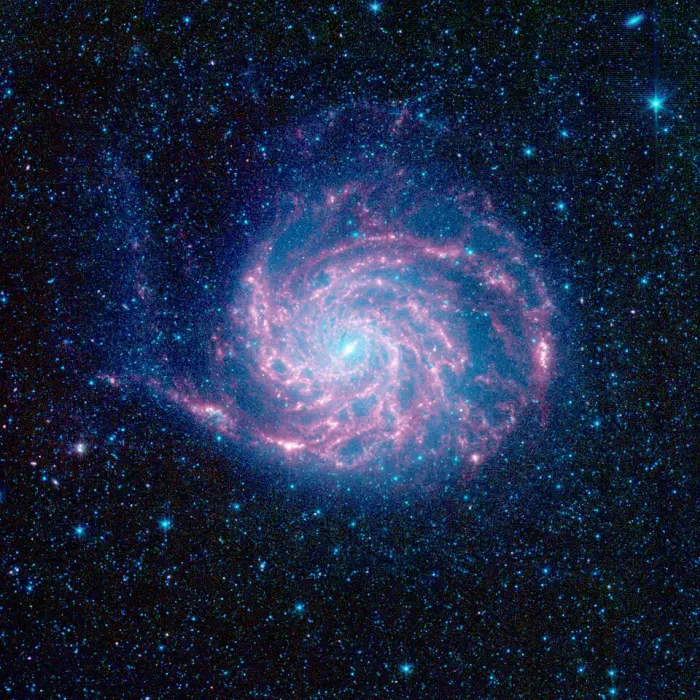
The tangled arms of the Pinwheel Galaxy, otherwise known as Messier 101, are decked out in red in this infrared image from NASA’s Spitzer Space Telescope. The red color shows the dust, while the blue glow around the galaxy is from starlight. In this infrared composite, blue indicates light with a wavelength of 3.6 microns, green corresponds to 4.5 microns, and red to 5.8 and 8.0 microns. The contribution from starlight (measured at 3.6 microns) has been subtracted from the 5.8- and 8-micron images to enhance the visibility of the dust features. Image credit: Karl D. Gordon (STScI) Charles W. Engelbracht (University of Arizona) George H. Rieke (University of Arizona) K. A. Misselt (University of Arizona) J.-D. T. Smith (University of Arizona) Robert C. Kennicutt Jr. (University of Cambridge) (PD)

This image shows the Pinwheel Galaxy, also known as M101, as viewed by ESA’s Herschel observatory. Lying more than 20 million light-years from us, this spiral galaxy is similar in shape to our Milky Way, but it is almost twice as large. Herschel’s observations at far-infrared and submillimetre wavelengths reveal the glow of cosmic dust, which is a minor but crucial ingredient in the interstellar material in the galaxy’s spiral arms. This mixture of gas and dust provides the raw material to produce the galaxy’s future generations of stars. The Pinwheel Galaxy is in the constellation Ursa Major, the Big Dipper. Thanks to its orientation, we can enjoy a face-on view of the beautiful spiral structure of the galaxy’s disc. The spiral arms are dotted with several bright, blue-hued spots of light: these are regions where large numbers of massive stars are being born. This three-colour image combines Herschel observations at 70 and 100 microns (blue), 160 and 250 microns (green), and 350 and 500 microns (red). North is up and east to the left. Credit: ESA/Herschel/NASA/JPL-Caltech; acknowledgement: R. Hurt (JPL-Caltech) (CC BY-SA 3.0 IGO)
X-ray
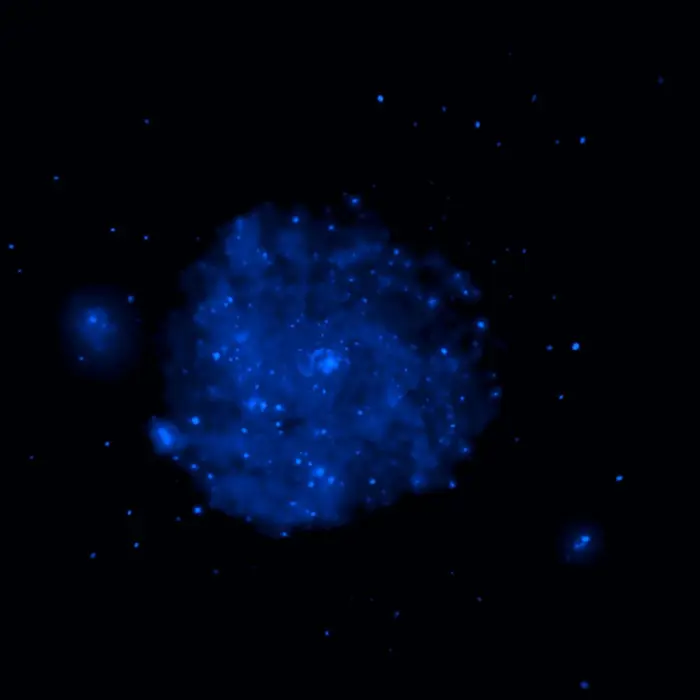
This image shows Chandra’s view of the Pinwheel Galaxy (Messier 101) in X-ray light. Credit: NASA, CXC, and K. Kuntz (JHU)

This Chandra image of M101 is one of the longest exposures ever obtained of a spiral galaxy in X-rays. The point-like sources include binary star systems containing black holes and neutron stars, and the remains of supernova events. Other sources of X-rays include hot gas in the arms of the galaxy and clusters of massive stars. Image credit: NASA/CXC/JHU/K.Kuntz et al. (PD)